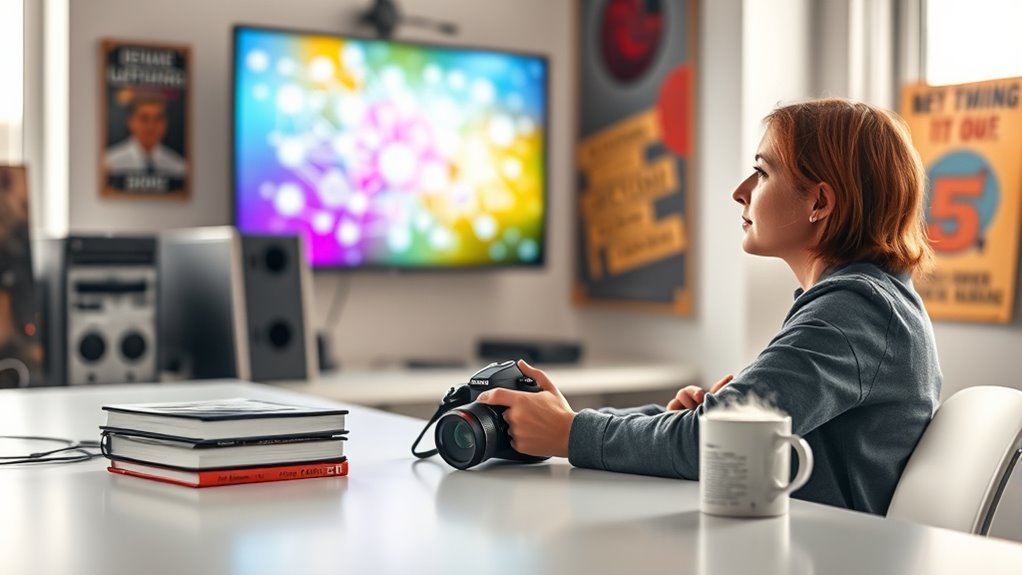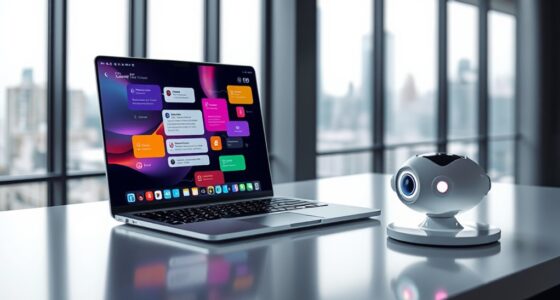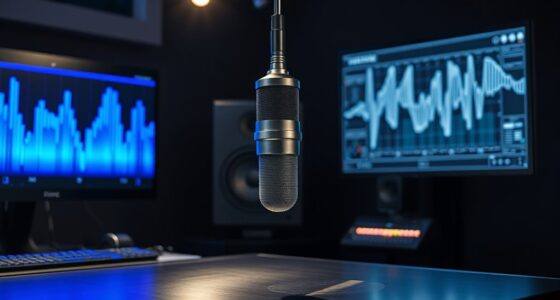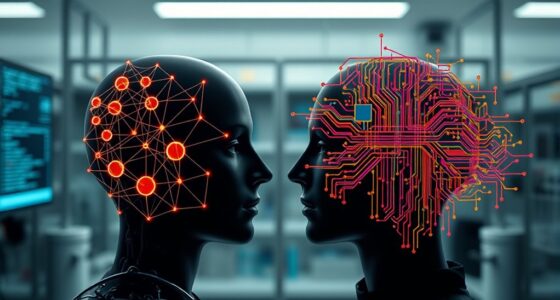Diffusion models are AI tools that turn random noise into realistic images, sounds, or videos by learning how to reverse a gradual noising process. During training, they learn to distinguish meaningful data from noise and figure out how to remove noise step-by-step. This allows them to generate high-quality, lifelike content that seems almost human-made. Keep exploring to discover how these models are revolutionizing media creation and what’s next.
Key Takeaways
- Diffusion models turn random noise into realistic images or sounds by learning to reverse a gradual noising process.
- They are trained by adding noise to data and teaching AI to remove it step-by-step to recover original content.
- During generation, diffusion models start with noise and iteratively refine it into detailed, high-quality media.
- They excel at creating photorealistic images, videos, and audio, surpassing traditional methods in realism and diversity.
- Diffusion models are transforming industries with their ability to produce lifelike media efficiently and creatively.
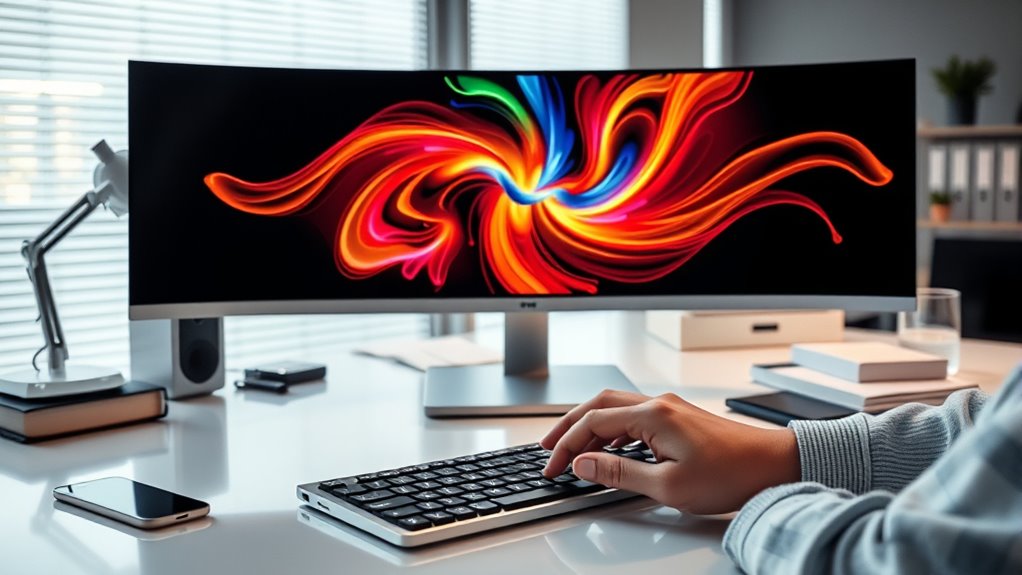
Have you ever wondered how computers generate realistic images or sounds from scratch? The secret lies in the fascinating world of diffusion models, a type of machine learning that’s reshaping how AI creates media. These models work through a straightforward yet powerful process that involves gradually transforming random noise into detailed, high-quality outputs. To do this effectively, they undergo a training process where the AI learns to reverse a noising process, step by step, until it can produce clear images or audio. During training, the model is fed countless examples, learning patterns and structures that help it understand how to reconstruct data from noise. This process makes diffusion models particularly good at generating realistic content, which is why they’re gaining attention for real-world applications like image synthesis, video generation, and even audio creation.
When you think about the training process, imagine it as teaching the AI to recognize the difference between chaotic noise and meaningful data. The model starts with clean images or sounds and gradually adds noise until they become unrecognizable. It then learns how to reverse this process—removing noise step by step to recover the original data. Over many iterations, the AI gets better at this task, learning the subtle details that distinguish realistic images from random noise. The key advantage here is that diffusion models don’t just memorize data; they learn the underlying distribution, allowing them to generate entirely new content that looks and sounds authentic. training process is a crucial factor in their ability to produce high-quality outputs.
In real-world applications, diffusion models are proving to be remarkably versatile. They’re used in creating photorealistic images for art, design, and entertainment, often surpassing traditional generative models in quality. In the field of healthcare, they help in generating synthetic medical images, which can be used for training or research without compromising patient privacy. These models also find their way into video editing, virtual reality, and even generating music or speech that’s indistinguishable from human creations. As they continue to improve and become more efficient, diffusion models are set to become integral tools across industries, transforming how content is created and used.
Frequently Asked Questions
How Do Diffusion Models Compare to GANS in Image Generation?
You’ll find diffusion models excel in generating high-quality images compared to GANs, especially in sampling efficiency. Unlike GANs that create images directly from latent space, diffusion models gradually refine noise into detailed images through a step-by-step process. This makes them more stable and less prone to mode collapse. While GANs are faster, diffusion models produce more diverse and realistic images, making them increasingly popular for advanced image generation tasks.
Can Diffusion Models Be Used for Text or Audio Synthesis?
You might wonder if diffusion models can be used for text or audio synthesis. The answer is yes—they’re increasingly applied in text-to-image generation, producing detailed images from text prompts. For audio synthesis, diffusion models are also making strides, creating realistic sounds and voices. While they excel in image tasks, ongoing research aims to enhance their capabilities for text and audio, making them versatile tools across different media.
What Are the Main Limitations of Diffusion Models Today?
You might wonder what holds diffusion models back today. The main limitations include scalability challenges, making them slow and resource-intensive, and interpretability issues, which obscure how they produce results. These hurdles create uncertainty and frustration, hinting at potential breakthroughs ahead. As researchers tackle these problems, you can’t help but feel excited about what’s possible when diffusion models become more efficient and transparent, revealing new creative frontiers.
How Long Does Training a Diffusion Model Typically Take?
Training a diffusion model typically takes days to weeks, depending on your computational resources. If you have access to powerful GPUs or TPUs, the process speeds up considerably, often completing in just a few days. However, limited resources can extend training duration to several weeks. You should also consider the dataset size and model complexity, which directly influence how long your training will last.
Are Diffusion Models Suitable for Real-Time Applications?
Think of diffusion models as artists painting slowly with delicate strokes. Their computational cost and sampling speed often limit real-time use, like trying to finish a masterpiece in a flash. While recent advancements improve speed, they still lag behind for instant results. If you need rapid responses, diffusion models might not be your best choice yet, but ongoing innovations promise to bring art and AI closer in real-time applications.
Conclusion
Now that you understand diffusion models, you’re better equipped to see how they turn noise into clear images. Think of it as finding the needle in the haystack—transforming chaos into clarity. With this knowledge, you’ll appreciate the magic behind AI-generated art and data synthesis. Keep exploring, because the more you learn, the more you’ll see how these models are shaping the future of technology. It’s all about connecting the dots and seeing the bigger picture.
